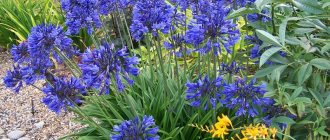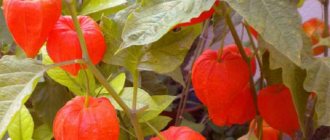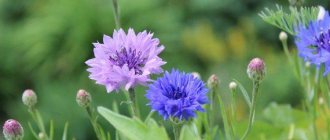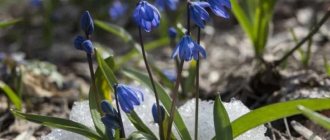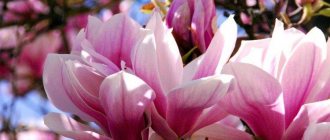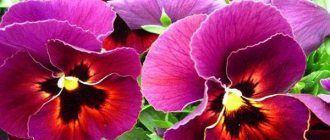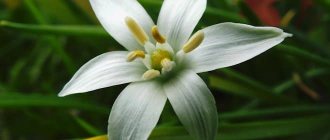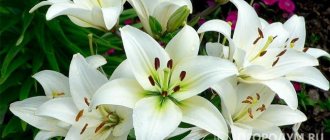Sometimes you want to plant some interesting and extraordinary, if not mysterious, plant in your garden plot. Most of these exotic garden pets, which can be bought in flower shops, are very capricious and require labor-intensive care. And yet, among the “exotics” you can always choose a cute, and most importantly, unpretentious plant that can be used to nicely decorate an empty flowerbed or front garden. Today we will talk about such an ornamental deciduous plant as Rogersia, we will talk about how to plant it in open ground, grow and care for this garden crop, as well as how to propagate it correctly.
Rogersia: varieties and varieties
The pretty exotic Rogersia is a large plant that has spectacularly settled in the parks and alleys of European cities. This garden crop is named after the American Admiral Rogers, who, having seen the charming plant, decided to take it out of China. By the way, about 9 species of Rogers grow there. Despite its beautiful and picturesque appearance, unpretentiousness and amazing resistance to the vagaries of nature, the perennial Rogersia is only gaining popularity in Russia.
Exotic culture takes root well in our gardens
This garden crop belongs to the Saxifraga family. Each Rogersia plant attracts with its monumentality and decorativeness. Growing more and more every year, this perennial plant forms a mighty flower bed, which consists of many vegetative rosettes and is completely strewn with peduncles reaching into the sky.
The length of the peduncles is impressive: it can reach 1.5 meters. Rogersia blooms from the beginning of spring to the end of summer with beautiful inflorescences of snow-white, soft yellowish and pinkish flowers, exuding the most delicate aroma. And all this beauty is surrounded by spectacular large leaves of juicy green color.
Rogersia concochestanfolia
To distinguish Rogers, just take a close look at the leaves: they can be palmate or pinnate. The most common is horse-chestnut-leaved Rogersia . The plant received such an unusual name due to the interesting shape of its leaves: they have clear similarities with the leaves of horse chestnut.
Rogersia stopiformis
Stop-shaped Rogersia also boasts palmately dissected leaves . True, the leaves have one peculiarity: there are large teeth along the edge, and at the end they seem to have been cut off. The flowering of this species can be observed a little earlier than the others, and it spreads more actively.
Rogersia pinnate
Pinnate Rogers has pinnate and slightly elongated leaves. Their length can reach 50 cm. This species will decorate your garden with juicy pink, creamy and white flowers.
Planting a plant
In order for Rogers to tirelessly delight you with colorful flowering, and its foliage not to lose its lush shape and emerald hue, the soil for planting must be enriched with humus, peat or compost. The root system is buried into the prepared soil by only 4-7 cm.
Attention! It is not recommended to plant the plant in areas exposed to sunlight, otherwise the leaves will begin to burn and the plant will most likely lose its decorative appearance.
Before planting Rogers, be sure to enrich the soil with fertilizers
. 2-3 years after planting, Rogers will reach adult size. This fact should definitely be taken into account if you are thinking about creating decorative flower arrangements in landscape design. The right place for planting and soil enriched with nutrients is half the success of growing a beautiful and healthy plant.
Preparation before planting Rogers in open ground
Despite the unpretentiousness of the culture, certain rules for planting Rogers in the ground should still be followed. This will help to grow a strong plant that will become a real garden decoration or an original element of a flower arrangement.
In order to properly plant and ensure the full development of the crop, it is necessary to follow certain recommendations for the selection of seedlings and places for the future placement of the crop.
Selection of seedlings
There are no specific rules for selecting seedlings specifically for Rogers, since the selection of planting material is carried out according to the same scheme as for other flower or foliage crops.
Firstly, it is better to purchase planting material from a trusted manufacturer. This way you will be sure that the seedlings were grown in optimal conditions and are not infected with fungus or other diseases. Secondly, when purchasing, you need to carefully examine the roots of the plant: they must be strong and well developed, without signs of dryness or rotting. It is this planting material that can ensure the successful cultivation of adult plants.
Choosing a landing site
If the choice of seedling is considered standard, then the selection of a place for planting a crop should be taken more carefully.
When planning the placement of Rogers on the site, you should consider the following features:
- It is better to choose a shaded place, since the culture does not tolerate intense lighting and exposure to direct sunlight.
- The bed for the plant should be large enough, since as the bush grows it takes up a lot of space and can oppress neighboring plants.
- The culture can be used to decorate the banks of reservoirs. It should be taken into account that, despite all its moisture-loving nature, the crop does not tolerate stagnation of moisture at the roots. Therefore, if groundwater is close to the site, additional drainage should be installed.
If you plan to grow several types of Rogers at once, you need to provide separate beds for them. The fact is that when placed close together, varieties can cross-pollinate.
Selection and preparation of soil for planting
Although Rogersia is an unpretentious crop and grows well in any soil, it is better to choose fertile areas with a high humus content in the soil. In addition, before planting, the soil must be thoroughly processed: freed from weeds and their roots, dug up and loosened.
Before planting, it is advisable to add fertilizer to the soil: peat, humus or manure. Rogersia develops well without additional fertilizing, but with it the shrub will quickly take root in a new place and begin to bloom. If the site has a high groundwater level, a drainage layer is placed at the bottom of each planting hole to protect the plant roots from waterlogging.
Rogers care
Caring for a garden plant is very simple: with the onset of spring, Rogersia is cleared of old leaves, the soil is mulched, and the crop is fed with organic fertilizers. You need to protect the plant from spring frosts using non-woven material.
Attention! If you notice that the roots are slightly peeking out of the soil, then they need to be sprinkled with earth. After the plant has flowered, all flower stalks are carefully cut off, dry and ugly leaves are removed, and closer to autumn, all shoots are cut off.
Growing and care
The Rogersia flower is quite easy to grow; it is resistant to diseases and pests. The perennial is resistant to frost; planting and caring for Rogers in the Moscow region occurs without any problems. Under suitable conditions, this Asian plant reaches large sizes. In just a few weeks, the shoots grow up to 1 meter in height, blooming huge, decorative leaves that make Rogers an extremely attractive, showy plant.
Requirements for soil and planting site
Rogersia's planting site requirements relate mainly to high soil moisture. Rogersias grow best in semi-shady to shady locations, but can grow in full sun (with regular watering, especially on hot days). This gives you plenty of room to maneuver when choosing a suitable position.
Plants prefer soil:
- wet,
- fertile,
- soil rich in humus.
Perennials like moist but well-drained soil to prevent their tuberous rhizomes from rotting in standing water. It is worth mulching the soil around the plant to prevent moisture loss.
Large perennials need plenty of room to grow freely. Once planted, they remain in one place for several decades. Rogersias can be grown in soil and in large containers.
Reproduction and planting
Rogersia reproduces in two ways:
- dividing rhizomes (in autumn),
- sowing seeds.
The best time for planting is early autumn. However, Rogers can be planted in spring or late August. At the end of the summer season, old plants can be divided into parts. To do this, the rhizomes are carefully dug up, divided into parts, separating one leaf from part of the underground part, and transplanted to a new location. Young plants should be protected from frost for the winter.
Separated rhizomes can be planted in pots as cuttings.
Diseases and pests
Rogers has no enemies. They are not attacked by diseases, even snails do not like large leaves. They can only suffer:
- excessive solar radiation,
- drought,
- spring frosts.
Wintering
Rogersia is a hardy plant, but in the Moscow region and in colder regions it requires frost-resistant shelter during very cold winters. It is better to plant the flower in places protected from the wind to protect large leaves from damage.
In autumn, the leaves of many varieties become slightly discolored before drying out. Before winter, dry leaves should be cut off the ground.
Spring care
The young leaves of the plant are very tender, and spring frosts can damage or even destroy them.
It is better to avoid planting Rogers in open areas, in lowlands with cold air. If night frosts are predicted, it is worth covering the plants for at least one night.
Varieties that start the growing season later than others are less susceptible to frost and can be grown in cooler areas:
- "Die Schöne"
- "Die Stolze"
- "Die Anmutige"
- "Spitzentänzerin"
- "White feather".
Fertilizer
Fertilize early in the growing season with a small amount of organic fertilizer in the spring. And that's all the perennial needs, provided it grows in the right conditions.
Fertilizer and feeding
Exotic Rogers will respond with gratitude to organic and mineral feeding, which is considered the most important element in growing the crop.
Feed the crop during the growing season to ensure active flowering
In addition to phosphorus, potassium and nitrogen, a comprehensive fertilizer for Rogers should contain the following microelements:
- copper;
- zinc;
- sulfur;
- molybdenum;
- magnesium.
Feeding is applied throughout the growing season, but it is especially important to help the plant during the period of active growth and flowering.
Disease and pests
Rogersia is resistant to various diseases, but it can still be affected by root rot. It develops due to stagnation of fluid in the roots. The affected bush exhibits yellowing and wilting of foliage, and they also darken very quickly. You can help the bush only when the appearance of rot has been noticed at an early stage. The bush is dug up, rotten areas are cut out and planted in another place.
Grape slugs and snails can also damage the flower. They are collected by hand from morning until lunch, and then the bush is sprayed with a specialized pesticide.
If the bush is infected with a rust fungus, cut off all diseased foliage and spray the plant with a fungicidal agent. The bush is treated in the daytime, since by evening its leaves should be dry. If the lighting in the area is excessively intense, brown spots and dry areas will form on the foliage. Replant the flower in the shade.
Rogersia propagation
If there is a need to divide the bushes of a crop, then choose spring or autumn for this. To plant plants, you can use the method of dividing rhizomes . With the onset of autumn, the root system is cut into small pieces (up to 10 cm) and planted in special boxes to a depth of 5-7 cm. For about 4 months, these boxes should be kept in a room with a temperature of +5 - +10ºС, and the soil in them should moisturize periodically. After the crop germinates, it is transplanted into a peat pot, and in the spring - into the ground.
The easiest way to propagate Rogers bushes is by dividing the rhizomes.
Propagation by seeds is used very rarely. And all because the germination rate of seeds is low, and the plants themselves will bloom only after 3-4 years.
The process of planting in open ground
After you have chosen a site and a crop seedling, you can proceed directly to planting. First of all, you need to prepare the flowerbed: remove all the weeds, dig up the soil and add peat, humus or compost to it (Figure 4).
Plant seedlings are placed in the prepared holes. It is important to take into account that the roots are buried into the soil no more than 6 cm.
Note: If the soil on your site is too wet, or groundwater is close to the surface, a drainage layer is placed at the bottom of each hole. This will protect the plant roots from excessive moisture and rotting.
The planting holes are sprinkled with a layer of fertile soil, lightly compacted and watered abundantly. It is advisable to lay a layer of organic mulch on top, which will prevent moisture evaporation and loss of nutrients.
Rogersia: combination with other plants
Due to the fact that Rogersia is very beautiful and decorative, in combination with other plants it forms unusual and picturesque plant compositions. A wonderful neighborhood was revealed with bergenia, ferns and delicate bells. The plant also looks very impressive in single-species flower beds, comfortably located in a dark place, for example, under the crown of a tree.
Rogersia in a flowerbed
Tall plants are also suitable as companions: with them they will create a single horizontal surface. The variegated mess that is formed by Rogers of various species and other shade-tolerant perennials (this can be red mountain weed, lungwort, periwinkle) looks beautiful.
Rogersia in landscape design
Rogersia in landscape design
Using this exotic plant, you can effectively decorate any flower bed, mixborder, or improve an artificial reservoir or pond. Rogersia perfectly complements a rocky garden and fits interestingly into large rock gardens, where it will act as a high-altitude dominant. But on small alpine hills it is better not to use Rogers due to its height.
general information
Rogersia is a moisture-loving and shade-loving plant native to the mountainous regions of Asia. It is valued for its large carved leaves, its ability to grow quickly and occupy the entire space. For the flowering season, the lush green crown is complemented by tall inflorescences.
Rogersia has a strong taproot, which gradually grows laterally with age. The average height of inflorescences is up to 1.5 m, but branches with leaves are usually lower. Erect branched shoots form a dense shrub.
The diameter of Rogers leaves easily reaches 50 cm. They can be of different shades - from green to red and bronze. There are varieties that change color throughout the season. Rogersia blooms in mid-summer, and after wilting, the leaves begin to grow even more actively.
Photo: krugosvetka.icu
